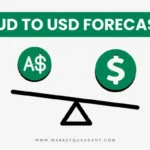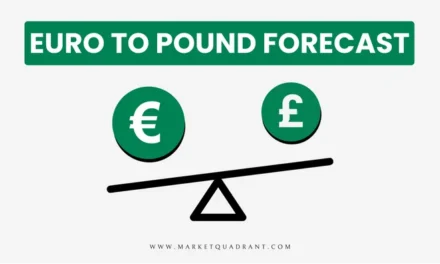
Australian Dollar to US Dollar Forecast for Tomorrow, This Week, and Month (AUD/USD)
AUD/USD is a forex ticker that shows the value of the Australian dollar against the US dollar. It tells traders how many Australian dollars are needed to buy one US dollar.
The AUD-USD currency pair is part of the major group and is ranked fourth in terms of frequency of trading in forex. This indicates that, in comparison to smaller and foreign currency pairs, it offers the lowest spreads and the highest liquidity.
Australia has one of the greatest economies in the world and is a significant supplier of coal, iron ore, and other minerals, in addition to precious metals. Because of its favorable correlation with global values, the Australian dollar (AUD) is frequently referred to as a “commodity currency” in the foreign exchange market.
Through this post, we will shed light on the intricacies of the Australian Dollar to US Dollar exchange rate and offer a comprehensive forecast for tomorrow and the week ahead.
On this page, you will find the latest information about the current price of the Australian dollar to the US dollar and forecast exchange rates for tomorrow, this week, and this month.
- The technical indicator data is updated based on a specific time frame.
- Australian dollar to US dollar exchange rate forecasts are updated daily.
- Price charts and the latest exchange rates are updated in real time.
Indicator-Based Technical Analysis of AUD/USD
You can find better entry points through the indications of the technical analysis tools given below.
- “Sell” or “Strong Sell” means that most signals are bearish.
- “Buy” or “Strong Buy” means that most signals are bullish.
Keep in mind that signals may vary in different time frames. For short-term transactions, it is recommended to use settings ranging from 5 minutes to 1 hour. And if you want to hold AUD/USD for more than a week, it is recommended to use settings ranging from days to weeks.
AUD to US dollar forecast for tomorrow, this week, and this month
The Australian dollar-to-US dollar exchange rate forecast for tomorrow is 0.664 US dollars.
| Date | Weekday | Min | Max | Rate |
|---|---|---|---|---|
| 07/07 | Monday | 0.643 | 0.663 | 0.653 |
| 08/07 | Tuesday | 0.642 | 0.662 | 0.652 |
| 09/07 | Wednesday | 0.642 | 0.662 | 0.652 |
| 10/07 | Thursday | 0.642 | 0.662 | 0.652 |
| 11/07 | Friday | 0.647 | 0.667 | 0.657 |
| 14/07 | Monday | 0.645 | 0.665 | 0.655 |
| 15/07 | Tuesday | 0.649 | 0.669 | 0.659 |
| 16/07 | Wednesday | 0.651 | 0.671 | 0.661 |
| 17/07 | Thursday | 0.654 | 0.674 | 0.664 |
| 18/07 | Friday | 0.655 | 0.675 | 0.665 |
| 21/07 | Monday | 0.652 | 0.672 | 0.662 |
| 22/07 | Tuesday | 0.649 | 0.669 | 0.659 |
| 23/07 | Wednesday | 0.652 | 0.672 | 0.662 |
| 24/07 | Thursday | 0.647 | 0.667 | 0.657 |
| 25/07 | Friday | 0.651 | 0.671 | 0.661 |
| 28/07 | Monday | 0.647 | 0.667 | 0.657 |
| 29/07 | Tuesday | 0.65 | 0.67 | 0.660 |
| 30/07 | Wednesday | 0.648 | 0.668 | 0.658 |
| 31/07 | Thursday | 0.649 | 0.669 | 0.659 |
| 01/08 | Friday | 0.651 | 0.671 | 0.661 |
| 04/08 | Monday | 0.65 | 0.67 | 0.660 |
| 05/08 | Tuesday | 0.651 | 0.671 | 0.661 |
| 06/08 | Wednesday | 0.654 | 0.674 | 0.664 |
| 07/08 | Thursday | 0.65 | 0.67 | 0.660 |
Current AUD/USD Chart Online
Latest Exchange Rates Online
Major Influences on the AUD USD Pair
Key factors affecting GBP/INR price:
- Chinese Economy: As a major consumer of Australian exports, China has a direct and significant impact on the AUD-USD price.
- Commodity Prices: Australia is a commodity-based economy. As a major exporter of commodities, Australia’s economy will be directly affected by global commodity prices. This will result in an impact on the Australian dollar and the AUD-USD rate.
- Interest Rates: Reserve Bank of Australia (RBA) and U.S. Divergence or convergence in interest rates between the Federal Reserve has a significant impact on the AUD/USD pair. Higher interest rates in Australia compared to the US could attract capital inflows and support the Australian dollar.
- US Federal Reserve: The Federal Reserve is the main institution influencing fluctuations in the price of the US dollar.
- Trade Balance: Australia’s trade balance and current account position, reflecting exports and imports, can influence the AUD/USD exchange rate. Thus, a trade surplus may contribute to a strengthening of the AUD, while a trade deficit may contribute to a weakening of the currency.
- Environmental factors: Increasingly, environmental considerations and sustainable practices can impact long-term economic prospects, as Australia is known to frequently suffer from natural disasters such as floods and fires, which impact the volume of industrial exports. Which may affect investors’ sentiments and the AUD/USD pair.
FAQs
Is the AUD/USD pair appropriate for beginners in trading?
The AUD/USD pair is considered good for beginners; it is one of the most popular currency pairs. It offers high liquidity and minimal spreads compared to smaller and foreign currency pairs. Due to this, this pair is considered a great pair to practice trading.
Additionally, it is more predictable and less prone to sudden spikes or drops, making it a better option for beginners.
When is the best time to buy the AUD/USD?
Australia’s economy is mostly dependent on the export of its goods. This indicates that when the prices of hard commodities are rising or are already very high, it is a good idea to purchase the Australian dollar. Moreover, as robust Asian demand is advantageous to both the Australian economy and the Australian currency, it is wise to monitor the demand for Australian commodities in that region.
What is the risk of trading AUD/USD?
There are inherent risks involved in trading any currency pair, including AUD/USD. Which includes market risk, economic risk, and political risk.
Price Prediction Methodology
The following tools are used to make predictions:
- Technical analysis is the basic tool. This involves studying price charts and using indicators to forecast future price movements. The analysis was mostly done on medium- and long-term time frames for more accurate results.
- Fundamental analysis involves examining the financial health and market factors of a company to predict its future performance.
- Predictive modeling uses statistical algorithms to forecast future prices based on historical data.
- Forecasts are based on consensus and expert opinion.
This article is intended for informational purposes only and does not constitute investment advice. Be aware of the high volatility of the forex market and consider these risks when making investment decisions.



























